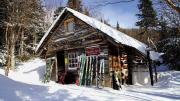In 1962, a group of hard-working, eager Harvard Mountaineering Club members with limited construction skills and tools managed to erect a log cabin on the eastern slope of Mount Washington. It’s still there—and anyone who wants to can trek two miles up through snow, ice, rain, or fog and use the place between December 1 and April 1. “Most of the people are ice-climbers and backcountry skiers,” says club president emeritus Vladislav Sevostianov ’19. “It’s the only full structure on the mountain where you can stay in the winter, which is part of what makes it so special.”
It’s certainly a unique place to spend time in nature—and off the grid. There’s solar-powered lights, a wood stove, propane for cooking, and an outhouse. Water is lugged in, or collected from a stream. About 16 people fit in the sleeping loft, and several nearby tent sites accommodate winter campers. To stay there, visitors merely check availability and sign up for space at the Gorham, New Hampshire, Pinkham Notch Visitor Center, adjacent to the Tuckerman Ravine Trail that leads to a cut-off route to the cabin. (The cabin is completely separate from the more accessible Harvard Outing Club cabin, which is operated in conjunction with the Appalachian Mountain Club.)
The Mountaineering Club’s base is primarily used to access ski trails, snow-shoeing routes, and a variety of ice-climbs. Some paths extend from the cabin, or others from the main Tuckerman Ravine Trail, including the Lion Head Trail, which is considered the best winter ascent to the Mount Washington summit. Proper clothing and gear—including ice axes and crampons, or other boot-traction devices—are absolute necessities, as is close monitoring of weather conditions. Avalanches are not uncommon, and each year people are injured, or die, in the White Mountains. The visitor Center offers daily, and sometimes hourly, weather and trail conditions. (The cabin’s on-site caretaker also has a radio for emergencies.)
The warnings aren’t intended to scare off visitors. Newcomers are always welcome, provided they learn to adapt to winter conditions. Ted Carman ’63, among those who led the cabin-building brigade, has hiked and ice-climbed throughout the White Mountains—and beyond. A few years ago he celebrated his seventy-fifth birthday at the cabin, scaling the 500-foot South Gully: “It’s the easiest of the snow and ice climbs, but I got a big kick out of it!”
As undergraduates, he and fellow club members requested permission from the U.S. Forest Service, which owns the land, to build a new structure in early 1962 after a preexisting Harvard cabin fell into disrepair. Approval was granted, but only, Carman learned years later, because “they thought there was no way college students” would succeed. That June, having eyed a likely site near Huntington Ravine, and hauled in supplies from Tuckerman Ravine—boards, nails, roofing, and at least a ton of Sakrete for the foundations—the students got to work.
Robert B. Redmayne ’65 captured the rookie exploits in amusing terms for the May 1963 Harvard Mountaineering Journal. “Clean healthy expectations of hard work in a spring scented forest were dulled into a dirty depression wrought by hours of clawing into the wet, sticky half-soil that covers the middle of slopes on the mountain,” he wrote. “And there is the procession of eager Harvard friends and acquaintances lured up by Ted Carman from weekend to weekend, shocked and appalled by the dirt and the work, exhausted and mute after two days.”
“We really didn’t even know how to get the trees, for the logs, down,” Carman recalls. “We’d cut them through and they’d tip, then just lean there, held up by adjacent trees.” Despite all that, after a few weeks of arduous 12-hour days, the neophytes had cleared the site, built nine foundation piers, bolted on the base logs, and installed the floor joists. Still, upon reflection, the group concluded it was time to hire professional help, which arrived in September in the form of an omni-talented local builder and woodsman, Freeman Holden. He transformed the students into productive underlings, and by October, the cabin was finished. “That December, we put in the wood stove, and the cabin’s been in use ever since,” Carman adds. “And really, the most remarkable part is that over the last 57 years, undergraduates at the club have taken care of this cabin. Someone has always stepped up and said, ‘I will take this on,’ and they do.”






